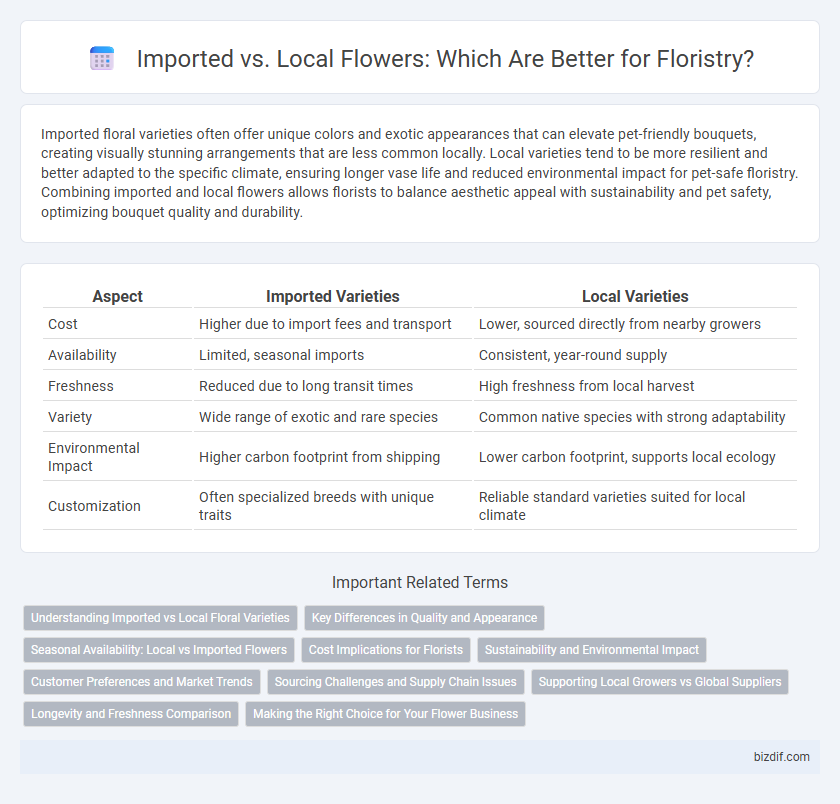Imported floral varieties often offer unique colors and exotic appearances that can elevate pet-friendly bouquets, creating visually stunning arrangements that are less common locally. Local varieties tend to be more resilient and better adapted to the specific climate, ensuring longer vase life and reduced environmental impact for pet-safe floristry. Combining imported and local flowers allows florists to balance aesthetic appeal with sustainability and pet safety, optimizing bouquet quality and durability.
Table of Comparison
| Aspect | Imported Varieties | Local Varieties |
|---|---|---|
| Cost | Higher due to import fees and transport | Lower, sourced directly from nearby growers |
| Availability | Limited, seasonal imports | Consistent, year-round supply |
| Freshness | Reduced due to long transit times | High freshness from local harvest |
| Variety | Wide range of exotic and rare species | Common native species with strong adaptability |
| Environmental Impact | Higher carbon footprint from shipping | Lower carbon footprint, supports local ecology |
| Customization | Often specialized breeds with unique traits | Reliable standard varieties suited for local climate |
Understanding Imported vs Local Floral Varieties
Imported floral varieties offer diverse colors and exotic appearances not commonly found in local markets, enhancing bouquet creativity and customer appeal. Local floral varieties provide advantages such as fresher blooms, longer vase life, and reduced transportation costs, promoting sustainability and affordability. Understanding the trade-offs between imported and local flowers is essential for florists to balance aesthetic diversity with environmental impact and cost efficiency.
Key Differences in Quality and Appearance
Imported flower varieties often exhibit unique colors, larger blooms, and exotic shapes due to diverse growing conditions and hybridization techniques, enhancing their visual appeal in floral arrangements. Local varieties typically offer fresher, more durable petals and stems, benefiting from shorter transportation times and adaptation to regional climates, which improves longevity and overall quality. While imported flowers may captivate with novelty, local varieties provide consistent quality and sustainable freshness that florists and customers highly value.
Seasonal Availability: Local vs Imported Flowers
Local flower varieties offer peak freshness and availability during their natural blooming seasons, ensuring vibrant colors and longer vase life. Imported flowers provide wider seasonal availability, allowing access to exotic varieties and blooms out of their native season. Balancing both imported and local flowers expands creative options for florists and meets diverse customer demands year-round.
Cost Implications for Florists
Imported flower varieties often carry higher costs due to international shipping, customs duties, and extended supply chains, impacting florists' pricing strategies. Local varieties typically offer fresher blooms at lower transportation expenses, enabling florists to reduce overhead and maintain competitive pricing. Seasonal availability and quality consistency also affect overall cost efficiency between imported and local floral selections.
Sustainability and Environmental Impact
Imported flower varieties often have a higher carbon footprint due to long-distance transportation and extensive packaging, contributing to increased greenhouse gas emissions. Local varieties support sustainable practices by minimizing transportation emissions and encouraging the use of native plants adapted to local soil and climate conditions. Emphasizing local floristry reduces environmental impact through lower resource consumption and promotes biodiversity conservation.
Customer Preferences and Market Trends
Imported flower varieties often attract customers seeking exotic colors and unique blooms not found locally, driving niche market demand in urban floristry shops. Local flower varieties appeal to eco-conscious consumers prioritizing sustainability and freshness, supporting seasonal sales and lower transportation costs. Market trends indicate a growing preference for locally sourced flowers, although premium imported varieties retain strong appeal for special occasions and luxury floral arrangements.
Sourcing Challenges and Supply Chain Issues
Imported flower varieties often face stringent customs regulations and longer transit times, leading to increased perishing risks and higher logistics costs in floristry supply chains. Local varieties benefit from shorter supply routes and fresher availability, but seasonal limitations and limited diversity can constrain floral designers' options. Balancing the reliability of domestic sourcing with the exotic appeal of imported blooms remains a critical challenge for florists managing inventory and meeting customer demand.
Supporting Local Growers vs Global Suppliers
Supporting local growers in floristry enhances sustainability by reducing carbon footprints associated with long-distance transportation of imported varieties. Local varieties often offer fresher blooms with a longer vase life due to shorter supply chains, benefiting both consumers and producers. Prioritizing regional florists strengthens community economies and preserves unique floral heritage amid global market pressures.
Longevity and Freshness Comparison
Imported flower varieties often undergo longer transportation times, which can reduce freshness and shorten vase life compared to local varieties. Local flowers typically retain higher moisture content and experience less handling stress, resulting in enhanced longevity and vibrant appearance. Choosing locally sourced blooms supports sustainability while ensuring fresher, longer-lasting floral arrangements.
Making the Right Choice for Your Flower Business
Choosing between imported varieties and local varieties is crucial for optimizing flower quality and cost-efficiency in your floristry business. Imported flowers often offer exotic appeal and year-round availability but may involve higher shipping costs and longer delivery times, impacting freshness. Local varieties provide fresher blooms, support regional growers, and reduce carbon footprint, enhancing sustainability and customer satisfaction.
Imported Varieties vs Local Varieties Infographic

 bizdif.com
bizdif.com